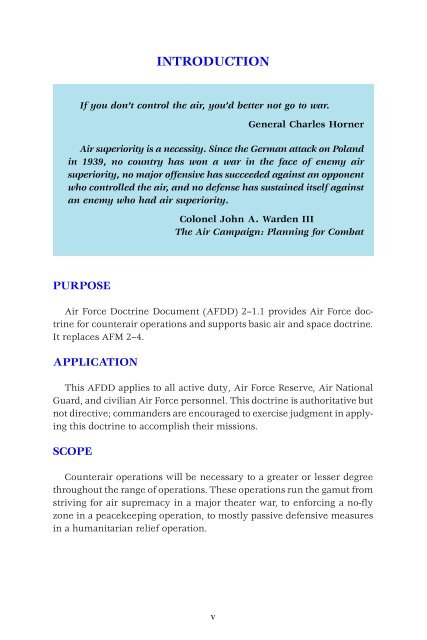Air Force Doctrine Document 2-1.1
Air Force Doctrine Document 2-1.1
Air Force Doctrine Document 2-1.1
You also want an ePaper? Increase the reach of your titles
YUMPU automatically turns print PDFs into web optimized ePapers that Google loves.
PURPOSE<br />
INTRODUCTION<br />
<strong>Air</strong> <strong>Force</strong> <strong>Doctrine</strong> <strong>Document</strong> (AFDD) 2–<strong>1.1</strong> provides <strong>Air</strong> <strong>Force</strong> doctrine<br />
for counterair operations and supports basic air and space doctrine.<br />
It replaces AFM 2–4.<br />
APPLICATION<br />
This AFDD applies to all active duty, <strong>Air</strong> <strong>Force</strong> Reserve, <strong>Air</strong> National<br />
Guard, and civilian <strong>Air</strong> <strong>Force</strong> personnel. This doctrine is authoritative but<br />
not directive; commanders are encouraged to exercise judgment in applying<br />
this doctrine to accomplish their missions.<br />
SCOPE<br />
If you don’t control the air, you’d better not go to war.<br />
Counterair operations will be necessary to a greater or lesser degree<br />
throughout the range of operations. These operations run the gamut from<br />
striving for air supremacy in a major theater war, to enforcing a no-fly<br />
zone in a peacekeeping operation, to mostly passive defensive measures<br />
in a humanitarian relief operation.<br />
v<br />
General Charles Horner<br />
<strong>Air</strong> superiority is a necessity. Since the German attack on Poland<br />
in 1939, no country has won a war in the face of enemy air<br />
superiority, no major offensive has succeeded against an opponent<br />
who controlled the air, and no defense has sustained itself against<br />
an enemy who had air superiority.<br />
Colonel John A. Warden III<br />
The <strong>Air</strong> Campaign: Planning for Combat
















